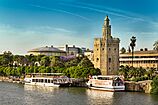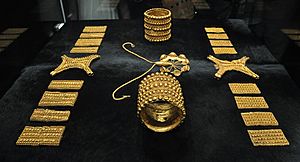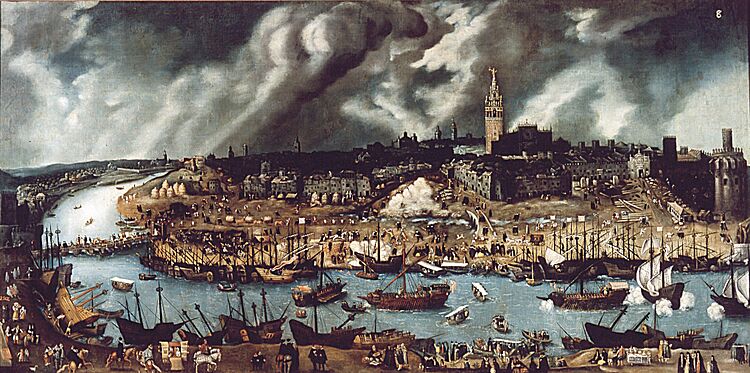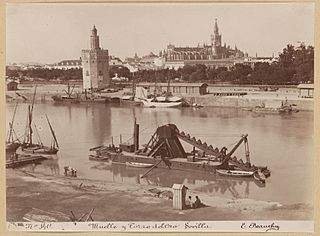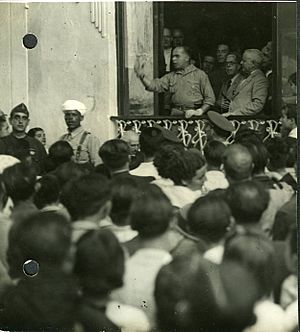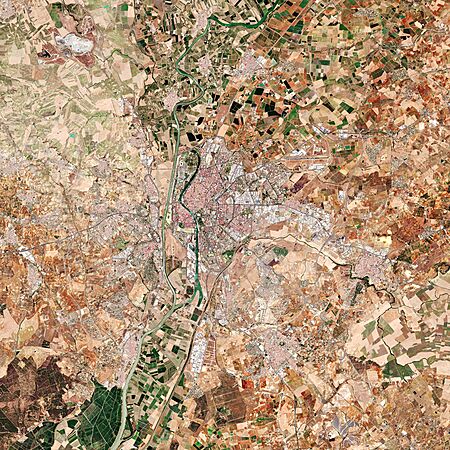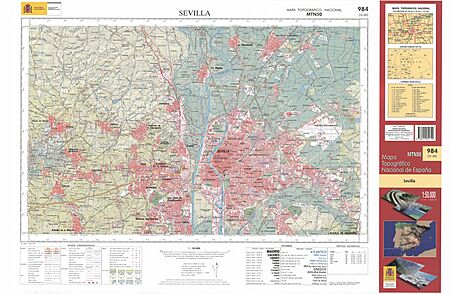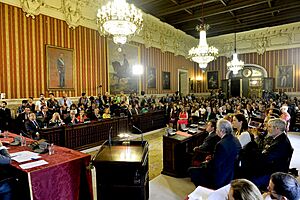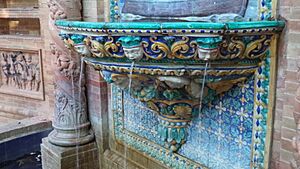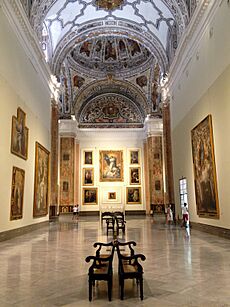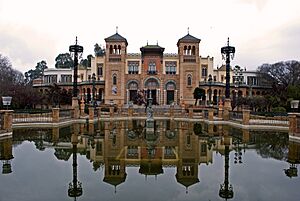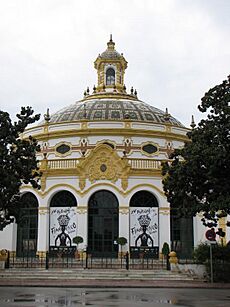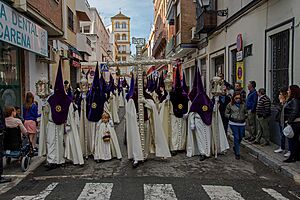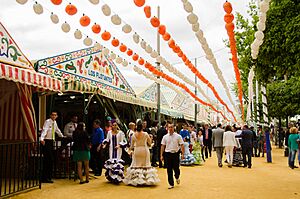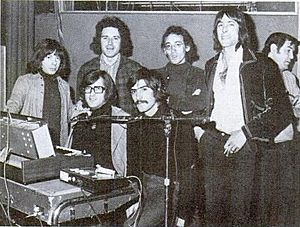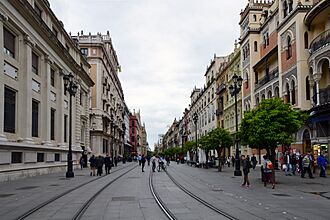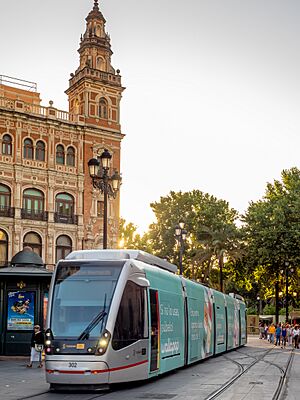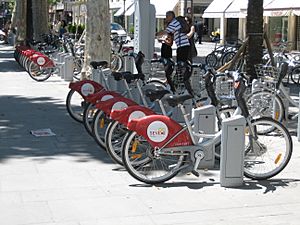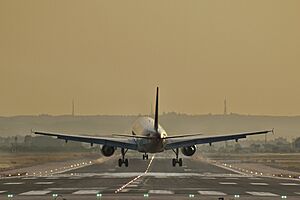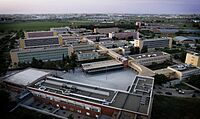Seville facts for kids
Quick facts for kids
Seville
Sevilla (Spanish)
|
|||
|---|---|---|---|
|
Cathedral of Saint Mary of the See
Torre del Oro and River Guadalquivir
Plaza de España
Metropol Parasol
Triana Bridge
|
|||
|
|||
| Motto(s):
NO8DO ([Ella] No me ha dejado – [She] has not abandoned me)
|
|||
| Country | |||
| Autonomous Community | |||
| Province | Seville | ||
| Government | |||
| • Type | Ayuntamiento | ||
| • Body | Ayuntamiento de Sevilla | ||
| Area | |||
| • Municipality | 140 km2 (50 sq mi) | ||
| Elevation | 7 m (23 ft) | ||
| Population
(2021)
|
|||
| • Municipality | 684,234 | ||
| • Rank | 4th | ||
| • Density | 4,890/km2 (12,700/sq mi) | ||
| • Urban | 1,100,000 | ||
| • Metro | 1,519,639 | ||
| Demonym(s) | Sevillan, Sevillian sevillano (m.), sevillana (f.) hispalense |
||
| GDP | |||
| • Metro | €36.785 billion (2020) | ||
| Time zone | UTC+1 (CET) | ||
| • Summer (DST) | UTC+2 (CEST) | ||
| Postcode |
41001–41020, 41070–41071, 41080, 41092
|
||
Seville (SƏ-vil; Spanish: Sevilla) is a large and important city in Spain. It is the capital of the Andalusia region and the province of Seville. The city is located on the River Guadalquivir in the southwest of the Iberian Peninsula.
About 701,000 people live in Seville as of 2022. This makes it the largest city in Andalusia and the fourth-largest city in Spain. The wider metropolitan area has about 1.5 million people. Seville's old town is a UNESCO World Heritage Site. It includes three famous buildings: the Alcázar palace, the Cathedral, and the General Archive of the Indies. Seville also has Spain's only river port, which is about 80 kilometers (50 miles) from the Atlantic Ocean. Summers in Seville are very hot, with daily temperatures often going above 35°C (95°F) in July and August.
Seville was first founded as a Roman city called Hispalis. After the Islamic conquest in 711, it was known as Ishbiliyah. It became a major city in the 16th century because it was the main port for trade between Spain and the Spanish Empire's lands in the Americas. The 17th century was a golden age for Seville's culture. In the 20th century, Seville hosted big events like the Ibero-American Exposition of 1929 and Expo '92. It also became the capital of the Andalusian region.
Contents
- Understanding Seville's Name and Motto
- Exploring Seville's Rich History
- Understanding Seville's Geography and Climate
- How Seville is Governed
- Seville's Population and Growth
- Discovering Seville's Main Sights
- Seville's Vibrant Culture
- Seville's Economy and Infrastructure
- Getting Around Seville
- Learning in Seville: Education
- Sports in Seville
- Seville in Stories and Films
- Twin Towns and Sister Cities
- Special Titles of Seville
- Notable People from Seville
- Images for kids
- See also
Understanding Seville's Name and Motto
What Does the Name Seville Mean?
The ancient name for Seville was Spal. This word meant "lowland" in the Phoenician language. Another old name was Hisbaal, which might be linked to the god Baal.
During Roman rule, the name changed to Hispal and then Hispalis. When the Umayyads arrived, it became Išbīliya in Arabic. The city was also sometimes called "Pearl of Andalusia". People from Seville are known as sevillanos (boys/men) or sevillanas (girls/women). They are also called hispalenses, after the Roman name.
Discovering Seville's Motto: NO8DO
Seville's official motto is NO8DO. This is a clever rebus (a puzzle that uses pictures or symbols to represent words). It stands for the Spanish phrase Spanish: No me ha dejado, which means "She [Seville] has not abandoned me." The "8" in the middle looks like a skein of wool, which is madeja in Spanish. So, it sounds like "no-madeja-do."
The story says that King Alfonso X gave Seville this motto. He lived in the city's Alcázar and the people of Seville supported him when his son tried to take his throne. You can see this emblem on Seville's flag and on many city items, like manhole covers. It's even on Christopher Columbus's tomb in the cathedral.
Exploring Seville's Rich History
Seville is about 2,200 years old. Many different civilizations have lived here, making the city unique. Its historical center is very well preserved.
Early Times: From Ancient Settlements to Roman Rule

Legend says the city was founded by Hercules. The oldest parts of Seville date back to the 8th century BC. At that time, Seville was an island in the Guadalquivir River. The Phoenicians and Tartessians called the town Hisbaal.
Later, during Roman times, it was known as Hispal and then Hispalis. Seville became a major market and industrial center. Nearby, the Roman city of Italica (where Roman emperors Trajan and Hadrian were born) was more of a residential city. You can still see Roman ruins in Italica and Carmona.
In Seville itself, you can find Roman remains. These include parts of an aqueduct, pillars from a temple, and columns in La Alameda de Hércules. The city walls were first built by Julius Caesar. However, their current look comes from later Moorish rebuilding. After Roman rule, Germanic groups like the Vandals and Visigoths took over.
The Middle Ages: Islamic Rule and Christian Conquest
In 712, Seville was taken by Islamic forces. It became an important city in Al-Andalus. In the mid-9th century, Vikings attacked Seville. They stayed for 40 days before leaving.
During Islamic rule, most people were converts to Islam, but there were also Christian and Jewish communities. In the 11th century, Seville became the capital of a powerful kingdom called the Taifa of Seville. This was a time when Seville was a center for learning and literature. Later, the city was ruled by the Almoravids and then the Almohads. The Almohads made Seville their main capital in Al-Andalus and greatly improved the city.

In 1247, Ferdinand III of Castile began a long siege of Seville. The city surrendered in 1248. After the Christian conquest, many public buildings were constructed. Churches were built in Mudéjar and Gothic styles, like the Seville Cathedral. Many Moorish buildings were changed into Catholic ones. The Moorish Palace became the royal residence, and later the Alcázar was built there.
In 1391, there was a sad event where many Jewish people were killed or forced to change their religion. Their synagogues were turned into churches. The first court of the Spanish Inquisition was set up in Seville in 1478. Its job was to make sure that people who had converted to Christianity were truly following the Christian faith.
The Golden Age and Later Changes
After Christopher Columbus's voyages to the Americas, Seville became the main port for trade with the New World in 1503. This was a huge deal for Seville. It was the only port allowed to trade with the Spanish Americas. This brought immense wealth to the city, and its population grew to over a hundred thousand people. This time is often called a "golden age" for Seville.
However, in the early 17th century, Seville's special trading rights began to fade. The Guadalquivir River started to get too shallow for large ships. So, the trade slowly moved to the port of Cádiz. A terrible plague in 1649 also greatly reduced Seville's population.
In the 18th century, King Charles III helped Seville's industries. The huge Real Fábrica de Tabacos was built. It was the second-largest building in Spain at the time. Today, it's part of the University of Seville. Seville is also famous in opera! More operas are set in Seville than any other European city, including famous ones like Carmen and The Barber of Seville.
Modern Seville: Growth and Big Events
In the 19th century, Seville grew a lot. New bridges were built, and street lighting and paving improved. The city expanded as parts of its old walls were taken down. The Sevillana de Electricidad Company brought electricity to the city in 1894.
In 1929, Seville hosted the Ibero-American Exposition. This event helped the city expand southward and created new public spaces like the Parque de María Luisa and the Plaza de España. The city also modernized its streets and built new hotels for the crowds.
During the Spanish Civil War in 1936, Seville quickly came under the control of General Queipo de Llano. After the war, Spain was neutral in World War II. Seville, like the rest of Spain, was somewhat isolated. In 1961, severe floods hit Seville when the River Tamarguillo overflowed.
In 1992, Seville hosted the Universal Exposition. This event brought huge improvements to the city's transport and infrastructure. A new ring road (SE-30) was completed, and new highways were built. The Seville-Santa Justa railway station opened, and the high-speed train (AVE) began running between Madrid and Seville. The Seville Airport also got a new terminal. Famous bridges like the Alamillo Bridge and the Centenario Bridge were built for the Expo.
More recently, the Metropol Parasol project, also known as Las Setas ('The Mushrooms'), was completed in 2011. This unique wooden structure revitalized a city square and now houses a market, an archaeological museum, and a viewpoint.
Understanding Seville's Geography and Climate
Where is Seville Located?
Seville covers an area of about 141 square kilometers (54 square miles). It is located in the fertile valley of the Guadalquivir River. The city is about 7 meters (23 feet) above sea level. Most of Seville is on the east side of the river. However, neighborhoods like Triana, La Cartuja, and Los Remedios are on the west side.
Seville is on the same latitude as San Jose, California in the United States and Seoul, the capital of South Korea. Even though it's not far from the coast, Seville has a more continental climate than coastal cities like Cádiz. This means its summers are much hotter.
Seville's Climate: Hot Summers and Mild Winters
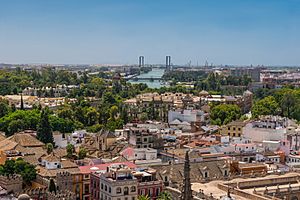
Seville has a hot-summer Mediterranean climate. This means it has very hot, long, and dry summers, and mild winters with some rain. The average yearly temperature is about 19.2°C (66.6°F). During the day, the average is 25.4°C (77.7°F), and at night it's 13.0°C (55.4°F).
Seville is in the Guadalquivir Valley, which is known for having some of the hottest cities in Spain. Seville is one of the warmest cities in Continental Europe. It has about 60 days a year where temperatures go above 35°C (95°F). Temperatures above 40°C (104°F) are common in summer. The highest temperature ever recorded at Seville Airport was 46.6°C (115.9°F) on July 23, 1995.
Snowfall is extremely rare in Seville. Since the year 1500, snow has only been reported about 10 times. The last snowfall was on February 2, 1954. Seville gets around 3000 hours of sunshine each year.
- Winters are mild. December and January are the coolest months, with average high temperatures around 16-17°C (61-63°F) and lows of 6-7°C (43-45°F).
- Summers are very hot. July and August are the hottest months, with average high temperatures around 35-36°C (95-97°F) and lows of 20-21°C (68-70°F).
- Rainfall is moderate, with about 50 rainy days per year. December is the wettest month.
| Climate data for Seville Airport (1991-2020) (Provisional normals), extremes (1941–present) | |||||||||||||
|---|---|---|---|---|---|---|---|---|---|---|---|---|---|
| Month | Jan | Feb | Mar | Apr | May | Jun | Jul | Aug | Sep | Oct | Nov | Dec | Year |
| Record high °C (°F) | 24.2 (75.6) |
28.0 (82.4) |
32.9 (91.2) |
36.9 (98.4) |
41.0 (105.8) |
45.2 (113.4) |
46.6 (115.9) |
45.9 (114.6) |
44.8 (112.6) |
37.4 (99.3) |
31.2 (88.2) |
24.5 (76.1) |
46.6 (115.9) |
| Mean daily maximum °C (°F) | 16.3 (61.3) |
18.3 (64.9) |
21.6 (70.9) |
24.0 (75.2) |
28.2 (82.8) |
32.9 (91.2) |
36.2 (97.2) |
36.2 (97.2) |
31.6 (88.9) |
26.3 (79.3) |
20.3 (68.5) |
16.9 (62.4) |
25.7 (78.3) |
| Daily mean °C (°F) | 11.2 (52.2) |
12.7 (54.9) |
15.6 (60.1) |
17.8 (64.0) |
21.6 (70.9) |
25.7 (78.3) |
28.5 (83.3) |
28.6 (83.5) |
25.0 (77.0) |
20.6 (69.1) |
15.2 (59.4) |
12.2 (54.0) |
19.6 (67.2) |
| Mean daily minimum °C (°F) | 6.0 (42.8) |
7.0 (44.6) |
9.5 (49.1) |
11.6 (52.9) |
14.9 (58.8) |
18.5 (65.3) |
20.7 (69.3) |
20.9 (69.6) |
18.4 (65.1) |
14.9 (58.8) |
10.1 (50.2) |
7.4 (45.3) |
13.3 (56.0) |
| Record low °C (°F) | −4.4 (24.1) |
−5.5 (22.1) |
−2.0 (28.4) |
1.0 (33.8) |
3.8 (38.8) |
8.4 (47.1) |
11.4 (52.5) |
12.0 (53.6) |
8.6 (47.5) |
2.0 (35.6) |
−1.4 (29.5) |
−4.8 (23.4) |
−5.5 (22.1) |
| Average precipitation mm (inches) | 56.3 (2.22) |
46.2 (1.82) |
46.9 (1.85) |
51.5 (2.03) |
33.9 (1.33) |
5.8 (0.23) |
0.6 (0.02) |
2.5 (0.10) |
33.1 (1.30) |
75.4 (2.97) |
72.6 (2.86) |
77.2 (3.04) |
502 (19.77) |
| Average precipitation days (≥ 1 mm) | 5.9 | 5.3 | 5.5 | 6.0 | 4.2 | 1.0 | 0.1 | 0.4 | 2.8 | 6.3 | 6.1 | 6.5 | 50.1 |
| Average relative humidity (%) | 74.8 | 67.8 | 62.0 | 57.8 | 51.1 | 45.5 | 42.4 | 45.6 | 54.1 | 63.5 | 71.5 | 76.5 | 59.4 |
| Mean monthly sunshine hours | 202.0 | 212.2 | 246.3 | 270.2 | 324.9 | 357.3 | 388.1 | 364.3 | 278.4 | 244.4 | 205.3 | 185.9 | 3,279.3 |
| Source 1: Agencia Estatal de Meteorologia (AEMET OpenData) for temperatures and precipitation | |||||||||||||
| Source 2: NOAA for precipitation days, humidity and sunshine | |||||||||||||
| Climate data for Seville Airport (1981–2010) | |||||||||||||
|---|---|---|---|---|---|---|---|---|---|---|---|---|---|
| Month | Jan | Feb | Mar | Apr | May | Jun | Jul | Aug | Sep | Oct | Nov | Dec | Year |
| Mean daily maximum °C (°F) | 16.2 (61.2) |
18.1 (64.6) |
21.9 (71.4) |
23.4 (74.1) |
27.2 (81.0) |
32.2 (90.0) |
36.0 (96.8) |
35.5 (95.9) |
31.7 (89.1) |
26.0 (78.8) |
20.2 (68.4) |
16.6 (61.9) |
25.4 (77.7) |
| Daily mean °C (°F) | 11.0 (51.8) |
12.5 (54.5) |
15.6 (60.1) |
17.3 (63.1) |
20.7 (69.3) |
25.1 (77.2) |
28.2 (82.8) |
27.9 (82.2) |
25.0 (77.0) |
20.2 (68.4) |
15.1 (59.2) |
11.9 (53.4) |
19.2 (66.6) |
| Mean daily minimum °C (°F) | 5.7 (42.3) |
7.0 (44.6) |
9.2 (48.6) |
11.1 (52.0) |
14.2 (57.6) |
18.0 (64.4) |
20.3 (68.5) |
20.4 (68.7) |
18.2 (64.8) |
14.4 (57.9) |
10.0 (50.0) |
7.3 (45.1) |
13.0 (55.4) |
| Average precipitation mm (inches) | 66 (2.6) |
50 (2.0) |
36 (1.4) |
54 (2.1) |
31 (1.2) |
10 (0.4) |
2 (0.1) |
5 (0.2) |
27 (1.1) |
68 (2.7) |
91 (3.6) |
99 (3.9) |
539 (21.2) |
| Average precipitation days (≥ 1 mm) | 6.1 | 5.8 | 4.3 | 6.1 | 3.7 | 1.3 | 0.2 | 0.5 | 2.4 | 6.1 | 6.4 | 7.5 | 50.5 |
| Average relative humidity (%) | 71 | 67 | 59 | 57 | 53 | 48 | 44 | 48 | 54 | 62 | 70 | 74 | 59 |
| Mean monthly sunshine hours | 183 | 189 | 220 | 238 | 293 | 317 | 354 | 328 | 244 | 217 | 181 | 154 | 2,918 |
| Source: Agencia Estatal de Meteorología | |||||||||||||
How Seville is Governed
Local and Regional Government
Seville is a municipality, which is the basic level of local government in Spain. The Ayuntamiento (City Council) manages the city. It has 31 elected council members who choose the mayor. The current mayor is José Luis Sanz from the People's Party, who started his role in June 2023.
Seville is also the capital of the Andalusia region. The historic Palace of San Telmo is where the president of the Andalusian Autonomous Government works. The Parliament of Andalusia meets in the Hospital de las Cinco Llagas.
Seville's Districts and Neighborhoods
Seville is divided into 11 districts, and these are further split into 108 neighborhoods. Some well-known districts include:
- Casco Antiguo (Old Town)
- Distrito Sur (South District)
- Triana
- Macarena
- Nervión
- Los Remedios
- Este-Alcosa-Torreblanca
- Cerro-Amate
- Bellavista-La Palmera
- San Pablo-Santa Justa
Seville's Population and Growth
| Historical population | ||
|---|---|---|
| Year | Pop. | ±% |
| 1842 | 100,498 | — |
| 1857 | 112,529 | +12.0% |
| 1860 | 118,298 | +5.1% |
| 1877 | 133,247 | +12.6% |
| 1887 | 143,840 | +7.9% |
| 1897 | 145,728 | +1.3% |
| 1900 | 147,271 | +1.1% |
| 1910 | 153,258 | +4.1% |
| 1920 | 205,723 | +34.2% |
| 1930 | 217,788 | +5.9% |
| 1940 | 302,300 | +38.8% |
| 1950 | 374,138 | +23.8% |
| 1960 | 441,869 | +18.1% |
| 1970 | 545,692 | +23.5% |
| 1981 | 645,817 | +18.3% |
| 1991 | 683,028 | +5.8% |
| 2001 | 684,633 | +0.2% |
| 2011 | 698,042 | +2.0% |
| 2021 | 684,340 | −2.0% |
| Source: National Statistics Institute | ||
As of 2021, Seville's population is 684,340. This is a small decrease from 2011, after a long time of continuous growth.
Discovering Seville's Main Sights
Seville is a very popular place for tourists in Spain. In 2018, over 2.5 million travelers visited the city. It's the third most visited city in Spain, after Madrid and Barcelona. Tourists come all year round because there are so many things to see and do. The Alcázar, the cathedral, and the General Archive of the Indies are all UNESCO World Heritage Sites.
Many of the city's most important sights are in the historic center (Casco Antiguo). The Macarena neighborhood to the north has important religious buildings. Across the river, the Triana neighborhood has played a big role in the city's history.
Famous Churches to Visit
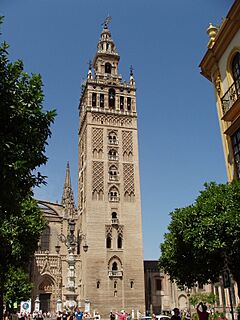
The Seville Cathedral, also known as the Cathedral of Saint Mary of the See, is thought to be the largest Gothic cathedral in the world. It was built on the site of the city's old main mosque, which was from the 12th century. The current Gothic building was started after 1401 and finished in 1506.
The cathedral holds important tombs, including one of the places believed to be the burial site of Christopher Columbus. It also has many important artworks. The cathedral's bell tower, the Giralda, was originally the minaret of the mosque. It's over 50 meters (164 feet) tall. In the 16th century, a Renaissance-style belfry was added, making it about 95 or 96 meters (312-315 feet) tall. The top has a weather vane sculpture called the Giraldillo, which is where the name "Giralda" comes from.
The Church of San Salvador is the second largest church in Seville. It was once the city's oldest mosque and was rebuilt in the 17th century in a Baroque style. The Church of Saint Louis of France is another beautiful example of Baroque architecture.
Grand Palaces and Mansions

South of the cathedral is the Alcázar, a huge palace and garden complex. It has been a center of power in Seville for centuries. The current palace was started in the 10th century and expanded over time. After the Christian conquest in the 13th century, much of it was rebuilt. King Pedro I built a new palace in the 1360s in the Mudéjar style, with help from craftsmen from Granada. This is why you see richly decorated rooms and courtyards like the Patio de las Doncellas.
Later, more parts were added in Renaissance style. The beautiful gardens were also redesigned. The Alcázar has even been used as a filming location for shows like Game of Thrones.

The Archbishop's Palace is built over the site of old Roman baths. The current building was mostly built in the second half of the 16th century. Its Baroque doorway was finished in 1704.
Many other old houses and wealthy mansions from the 16th century are still standing. One of the most famous is the Casa de Pilatos ('House of Pilate'). This aristocratic mansion mixes different architectural styles, like older Isabelline and Mudéjar designs with later Renaissance elements. Other historic mansions include the Palace of the Countess of Lebrija and the Palacio de las Dueñas.
Historic Fortifications

The city walls were first built by Julius Caesar. After a Viking attack in 844, they were rebuilt. They were expanded even more in the 12th and 13th centuries. Most of the walls were taken down after 1861 to allow the city to grow. However, a large part of the northern walls can still be seen today.
The Torre del Oro (Tower of Gold) is a defensive tower built in 1220–1221. It was part of the city's defense system and protected the harbor. A chain could be raised between this tower and another across the river to block ships from entering the port.
Important Civic Buildings and Monuments

The City Hall (Ayuntamiento) was started in 1527. Its eastern side, facing Plaza de San Francisco, is a great example of the Plateresque style. The building was later remodeled and given a new western side in a Neoclassical style.
The General Archive of the Indies (Archivo General de Indias) holds important historical documents about the Spanish Empire in the Americas and the Philippines. The building itself was designed in 1572 to house the merchants' guild. It was turned into the Archive in 1785.

The Palacio de San Telmo was originally a naval college, built starting in 1671. Its current front, finished in the 1730s, is a very important example of Baroque architecture in Andalusia. Today, it is the home of the Andalusian Autonomous Government.
The Royal Tobacco Factory (Real Fábrica de Tabacos) was built between 1728 and 1771. It was designed in a Baroque style. When it was finished, it was the largest industrial building in the world. It even had its own chapel and prison! Since the 1950s, it has been part of the University of Seville.
The city's bullring, the Real Maestranza, was designed in 1761. Its Baroque front was completed in 1787. The bullring can hold 14,000 people.
The Metropol Parasol, also known as Las Setas ('The Mushrooms'), is the world's largest wooden structure. This modern, umbrella-like building was finished in 2011. It houses a market and an underground archaeological museum. You can also go to the top for great views of the city.
Exploring the Parque de María Luisa
The large Parque de María Luisa (María Luisa Park) was designed for the 1929 Ibero-American Exposition. The park has two main plazas, the Plaza de España and the Plaza de América, along with many monuments and museums. These buildings show off a mix of styles, including Neo-Mudéjar and Neo-Renaissance, decorated with beautiful glazed tiles.
At the north end of the park, the Plaza de España is a semi-circular plaza with tall towers. It has benches covered in painted tiles, each dedicated to one of Spain's 48 provinces. This location has been used in several movies.
At the south end of the park, the Plaza de América is surrounded by three buildings that look like different historical styles. Two of these buildings are now museums.
Seville's Museums and Art Collections
The most important art collection in Seville is at the Museum of Fine Arts of Seville. It opened in 1835. It has many famous artworks by artists like Murillo, Zurbarán, and Valdés Leal. It also has Flemish paintings from the 15th and 16th centuries.
Other interesting museums in Seville include:
- The Archeological Museum of Seville: This museum has collections from ancient times, including the Tartessian, Roman, and Almohad periods. It's in Plaza América in Parque de María Luisa.
- The Museum of Arts and Popular Customs of Seville: Also in Plaza América, across from the Archaeological Museum.
- The Andalusian Contemporary Art Centre: Located in La Cartuja.
- The Naval Museum: Housed in the Torre del Oro, by the River Guadalquivir.
- The Flamenco Art Museum.
- The Bullfighting Museum: In the Maestranza bullring.
- The Palace of the Countess of Lebrija: A private collection with many mosaic floors from the Roman town of Italica.
- The Centro Velázquez (Velázquez Centre): Located in the Old Priests Hospital.
- The Antiquarium: An underground museum in Metropol Parasol, showing important Roman archaeological remains.
- The Castillo de San Jorge (Castle of St. George): Near the Triana market, it was the last home of the Spanish Inquisition.
- The Museum and Treasure of La Macarena: Shows the collection of the Macarena brotherhood, giving a good idea of Seville's Holy Week.
- La Casa de la Ciencia (The House of Science): A science center and museum.
- Museum of Pottery in Triana.
- Pabellon de la Navegación (Pavilion of Navigation).
More Parks and Gardens to Explore
Besides the large Parque de María Luisa, Seville has other beautiful parks and gardens:
- The Alcázar Gardens: These gardens are part of the Alcázar palace and have different sections designed in various historical styles.
- The Gardens of Murillo and the Gardens of Catalina de Ribera: Both are along the south wall of the Alcázar, next to the Santa Cruz quarter.
- The Parque del Alamillo y San Jerónimo: The largest park in Andalusia, built for Seville Expo '92. It has native Andalusian plants. A large bronze sculpture called The Birth of a New Man (also known as Columbus's Egg) is located here.
- The American Garden: Also created for Expo '92, it's a public botanical garden with plants from the Americas.
- The Buhaira Gardens: A public park and historic site, originally a garden estate from the Almohad period (12th century).
Seville's Vibrant Culture
Theatres and Performances
The Teatro Lope de Vega was built in 1929 for the Ibero-American Exhibition. It is a beautiful example of Spanish Baroque Revival style. It hosts many different performances, including theater, dance, opera, jazz, and flamenco. It is now one of the most important theaters in Spain.
Other important theaters in Seville are Teatro de la Maestranza, Auditorio Rocío Jurado, and Teatro Central.
Exciting Festivals and Celebrations
Seville is known for its many festivals throughout the year. Some focus on religion and culture, while others celebrate local traditions and entertainment.
Holy Week in Seville
Semana Santa (Holy Week) is celebrated across Spain, but Seville's celebration is especially famous. It's considered a Fiesta of International Tourist Interest. Fifty-four local brotherhoods, or "cofradías," organize floats and processions all week. These events retell the story of the Passion of Christ. Traditional music and art are part of the processions, making Holy Week a very important cultural event in Seville.
Bienal de Flamenco
Seville hosts the Bienal de Flamenco every two years. This festival is called "the biggest flamenco event worldwide" and lasts for almost a month.
Velá de Santiago y Santa Ana
In the Triana district, the Velá de Santiago y Santa Ana is held every July. It includes sports events, performances, and cultural activities. The city honors St. James and St. Ana during this festival.
Feria de Abril (April Fair)
The April Fair (Feria de Abril) is a huge celebration that takes place about two weeks after Holy Week. It used to be about livestock, but now it's a fun, joyful event celebrating Spanish folklore.
During the Feria, families, businesses, and organizations set up casetas (marquees or tents). They spend the week dancing and socializing in these tents. Women traditionally wear beautiful flamenco dresses, and men wear their best suits. The casetas are set up on a permanent fairground in the Los Remedios district.
Music Scene in Seville
Seville had a lively rock music scene in the 1970s and 1980s. Bands like Triana mixed Andalusia's traditional flamenco music with progressive rock. Later, punk rock and indie bands became popular. Today, Seville's music scene includes rap artists like SFDK and Mala Rodríguez.
The city also has many theaters and places for classical music, such as Teatro Lope de Vega and Teatro La Maestranza.
Even though it sounds like it, the sevillana dance is not originally from Seville. However, the folk songs called sevillanas are truly from Seville, as is the four-part dance performed with them.
In November 2023, Seville hosted the 24th Annual Latin Grammy Awards. This was the first time the Latin Grammy Awards were held outside the United States.
Flamenco: Seville's Heartbeat
The Triana district in Seville is considered a birthplace of flamenco. It started there as a way for poor and marginalized people to express themselves. Seville's Gypsy population, known as Flamencos, were very important in developing this art form. Flamenco is a symbol of Andalusian culture and a national heritage symbol of Spain.
Seville has more flamenco artists than any other place in Spain. This supports a whole industry around flamenco and brings many tourists to the city.
Delicious Food in Seville
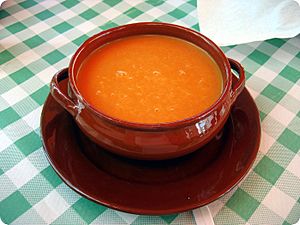
The tapas scene is one of Seville's main cultural attractions. People go from one bar to another, enjoying small dishes called tapas. These dishes were probably named "lids" or "covers" because they were served on small plates used to cover drinks.
Local specialties include fried and grilled seafood like squid and cuttlefish. You can also find grilled and stewed meats, spinach with chickpeas, Jamón ibérico (cured ham), and gazpacho (a cold soup). A sandwich called a serranito is a popular fast food option.
Typical desserts from Seville include pestiños (honey-coated fritters) and torrijas (fried bread with honey). Polvorones and mantecados are traditional Christmas treats.
Bitter Seville oranges grow on trees lining the city streets. Many are collected and sent to Britain to make marmalade. In Seville, the fruit is mainly used for aromatherapy and herbal medicine. Legend says Arabs brought the bitter orange to Seville around the 10th century to make patios and gardens beautiful and fragrant. The flowers of the tree are used to make neroli oil, which is used in perfumes.
In 2021, the city's water company started a project to use the methane from fermenting oranges to create clean electricity. They plan to use 35 tonnes of fruit to power one of the city's water purification plants.
Seville's Economy and Infrastructure
Seville is the most populated city in southern Spain. It has the largest GDP (gross domestic product) in Andalusia, making up a quarter of the region's total. The economy of the surrounding towns depends on Seville. While smaller villages focus on agriculture, Seville has growing industrial and commercial areas.
Seville's economy is mostly based on services, but industry is still important. The city has good transportation links to other Spanish cities.
Modern Infrastructure and Development
The 1990s saw huge investments in Seville's infrastructure, especially because of the Universal Exposition of Seville in 1992. This helped the city's economy grow. Seville now has a high-speed AVE railway connection to Madrid and a new international airport.
Seville has Spain's only inland port, located 80 kilometers (50 miles) from the sea. This port connects southern Spain with Europe, the Middle East, and North Africa. The port handles millions of tonnes of goods each year.
Cartuja 93 is a research and development park that employs 15,000 people. The Parque Tecnológico y Aeronáutico Aerópolis focuses on the aircraft industry. Seville also uses its sunny weather to power the city with clean, renewable energy from nine PS20 solar power towers.
The Sevilla Tower skyscraper was completed in 2015. At 180.5 meters (592 feet) tall, it is the tallest building in Andalusia. Seville also has large conference facilities, like the Conference and Convention Centre.

Research and Innovation in Seville
The Consejo Superior de Investigaciones Científicas en Sevilla (CSIC) is a research center located in the former Pavilion of Peru. In 2008, the city council helped create the Casa de la Ciencia (Science Centre) to get more people interested in science. Seville is also a key center for research in renewable energy and the aeronautics industry.
The Parque Científico Tecnológico Cartuja 93 is a hub for research in many areas. These include telecommunications, new technologies, biotechnology, environmental studies, and renewable energy.
Getting Around Seville
Bus Services
Seville has a public bus network called TUSSAM (Transportes Urbanos de Sevilla). Buses run throughout the city. The Consorcio de Transportes de Sevilla also connects Seville by bus to all the nearby towns.
There are two main bus stations for travel to other cities: Plaza de Armas Station (for destinations north and west) and Prado de San Sebastián Station (for routes south and east). You can take direct buses from Plaza de Armas to many Spanish cities and even to Lisbon, Portugal.
Metro System
The Seville Metro (Metro de Sevilla) is a light metro network that serves Seville and its surrounding area. It is completely separate from other traffic. All stations have platform screen doors for safety.
It was the sixth metro system built in Spain. It currently has one line with 22 stations and is planning to add three more lines.
Tram Service
MetroCentro is a tramway that runs through the city center. It started operating in October 2007.
It has five stops: Plaza Nueva, Archivo de Indias, Puerta de Jerez, Prado de San Sebastián, and San Bernardo. There are plans to extend it to the Santa Justa AVE train station.
Train Connections
The Seville-Santa Justa railway station is served by the AVE high-speed rail system, run by the Spanish state-owned company Renfe. A five-line commuter rail service (Cercanías) connects the city with its metropolitan area. Seville is part of the Red Ciudades AVE, which links it to 17 major Spanish cities by high-speed rail.
Even though Seville is close to Faro in Portugal, you cannot cross the border by train.
Biking in Seville
The Sevici community bicycle program has made bicycles a part of public transport. You can rent bicycles cheaply around the city. Green bicycle lanes are on most major streets. The number of people using bicycles in Seville has grown a lot, increasing tenfold from 2006 to 2011. As of 2015, about 9% of all trips in the city are made by bicycle.
The public bicycle rental system is funded by an advertising company. In return, the city gives the company a 10-year license to use city billboards. Recently, e-bike companies like Lime (transportation company) have also started operating in Seville.
Airport Services
The San Pablo Airport is Seville's main airport. It is the second busiest airport in Andalusia, after Málaga's, and the busiest for cargo. In 2019, it handled over 7.5 million passengers. It has one terminal and one runway.
The airport is a base for low-cost airlines like Vueling and Ryanair. Ryanair also opened its first aircraft maintenance facility in Spain at Seville Airport in 2019. This allows for affordable direct flights to many Spanish and European cities.
Seville's River Port
Seville has the only commercial river port in Spain. It is also the only inland city in the country where cruise ships can arrive right in the historic center. This port connects Seville to the Atlantic and Mediterranean, allowing trade between southern Spain and Europe, the Middle East, and North Africa.
Road Network
Seville has a ring road called the SE-30. This road connects to major highways like the A-4, which links Seville to Cádiz, Cordoba, and Madrid. The A-92 highway connects Seville to cities like Granada and Almeria. The A-49 links Seville to Huelva and the Algarve region in southern Portugal.
Public Transport Use Statistics
On average, people in Seville spend about 34 minutes commuting with public transport on a weekday. About 7% of public transport riders travel for more than two hours each day. The average wait time at a stop is eight minutes, but 15% of riders wait for over 20 minutes daily. The average distance people travel in a single public transport trip is 5.6 kilometers (3.5 miles).
Learning in Seville: Education
Seville has three public universities:
- The University of Seville (US), founded in 1505, had 72,000 students in 2019.
- The Pablo de Olavide University (UPO), founded in 1997, had 9,152 students in 2019.
- The International University of Andalusia (UNIA), founded in 1994.
The US and UPO are important learning centers in Western Andalusia, offering many different courses. This means many students from nearby provinces like Huelva and Cádiz come to study in Seville.
There are also international primary and secondary schools in Seville, including:
- Lycée Français de Séville (French school)
- Deutsche Schule Sevilla (German school)
- St. George's British School
Seville also has many international schools and colleges for American students who come to study abroad.
Sports in Seville
Seville is home to two rival football teams: Real Betis Balompié and Sevilla Fútbol Club. Both teams play in La Liga, Spain's top football league. Each team has won the league once. Sevilla FC has also won European competitions, including the UEFA Europa League multiple times.
The stadiums of Sevilla FC (Ramón Sánchez Pizjuán) and Real Betis (Benito Villamarín) were used for the 1982 FIFA World Cup. Sevilla's stadium also hosted the 1986 European Cup final. The Estadio de La Cartuja, built in 1999, was the venue for the 2003 UEFA Cup final. Seville also has a basketball club, the Real Betis Baloncesto.
Seville has hosted major athletics events, including the indoor (1991) and outdoor (1999) World Championships. The city also hosted the tennis Davis Cup final in 2004 and 2011. Seville's River Guadalquivir is one of only three FISA-approved international training centers for rowing. The 2002 World Rowing Championships and the 2013 European Rowing Championships were held there.
Seville in Stories and Films
- The novel Rinconete y Cortadillo by Miguel de Cervantes takes place in Seville.
- Seville is the setting for the legend of Don Juan.
- Many famous operas are set in Seville, including Bizet's Carmen, Rossini's The Barber of Seville, and Mozart's Don Giovanni.
- Seville is a setting in Dan Brown's novel Digital Fortress.
- The Plaza de España in Parque de María Luisa has appeared in movies like Star Wars: Episode II – Attack of the Clones and Lawrence of Arabia.
- The Alcázar and other sites appear in the television series Game of Thrones.
- In the 2016 film Assassin's Creed, characters escape through the city, even jumping from an unfinished Seville Cathedral.
Twin Towns and Sister Cities
Seville has special relationships with other cities around the world, called twin towns or sister cities:
 Angers (France), 1989.
Angers (France), 1989. Barcelona (Spain), 1987.
Barcelona (Spain), 1987. Buenos Aires (Argentina), 1976.
Buenos Aires (Argentina), 1976. Columbus, Ohio (United States), 1988.
Columbus, Ohio (United States), 1988. Córdoba (Spain), 1908.
Córdoba (Spain), 1908. Guadalajara (Mexico), 1984.
Guadalajara (Mexico), 1984. Havana (Cuba), 2007.
Havana (Cuba), 2007. Kansas City, Missouri (United States), 1969. Kansas City has a small replica of Seville's Giralda tower.
Kansas City, Missouri (United States), 1969. Kansas City has a small replica of Seville's Giralda tower. Laredo (Spain), 2017.
Laredo (Spain), 2017. Marrakech (Morocco), 2017.
Marrakech (Morocco), 2017. Medina de Rioseco (Spain), 2016.
Medina de Rioseco (Spain), 2016. San Salvador (El Salvador), 2018.
San Salvador (El Salvador), 2018. Sevilla la Nueva (Spain).
Sevilla la Nueva (Spain).
- Partnerships
 Kraków (Poland), 2002.
Kraków (Poland), 2002.
Special Titles of Seville
Seville has received many special titles from Spanish monarchs and leaders throughout its history:
- Very Noble: Given by King Ferdinand III of Castile after he took the city back.
- Very Loyal: Given by King Alfonso X of Castile for supporting him during a rebellion. This is linked to the motto "NO8DO".
- Very Heroic: Given by King Ferdinand VII of Spain in 1817 for its bravery against the French invasion.
- Invictus (Invincible in Latin): Given by Queen Isabella II of Spain for the city's strong resistance in 1843.
- Mariana: Given by General Francisco Franco in 1946 for the city's strong devotion to the Virgin Mary.
Notable People from Seville
Historical Figures
- Al-Mu'tamid ibn Abbad: A poet and Arabic king of Seville (1040–1095).
- Physician Avenzoar.
- The family of the Arabic historian and sociologist Ibn Khaldun.
- 13th-century poet Ibn Sahl of Seville.
- Renaissance composers Cristóbal de Morales and Francisco Guerrero.
- 16th-century novelist Mateo Alemán.
- Playwrights Lope de Rueda and Hermanos Alvarez Quintero.
- Historian of New Spain Bartolomé de Las Casas.
- Baroque painters Diego Velázquez, Valdés Leal, and Bartolomé Esteban Murillo.
- Romantic poet Gustavo Adolfo Bécquer.
- Bullfighters Juan Belmonte, Curro Romero, and Ignacio Sánchez Mejías.
- Former Prime Minister of Spain Felipe González.
20th-Century Artists and Performers
- Vicente Aleixandre (Nobel Laureate in Literature).
- Poets Antonio and Manuel Machado.
- Composer Joaquín Turina.
- Drag queen Carmen Farala, winner of the first season of Drag Race España.
- Actors Juan Diego and Paco León.
- Actresses Soledad Miranda, Verónica Sánchez, Carmen Sevilla, and Paz Vega.
- El Risitas, a humorist.
- Singers Isabel Pantoja, Juanita Reina, Lole y Manuel, Mala Rodríguez, and Pastora Soler.
Athletes
- Footballers José Antonio Reyes, Sergio Ramos, Jesús Navas, Antonio Puerta, Olga Carmona, and Irene Guerrero.
- Olympic swimmer Fátima Madrid.
Images for kids
-
Cathedral of Saint Mary from Constitución Avenue.
See also
 In Spanish: Sevilla para niños
In Spanish: Sevilla para niños
- Azulejo
- Cadillac Seville, a car that was named after the city
- Church of Santa Maria la Blanca (Seville)
- Isla Mágica
- Seville Public Library



